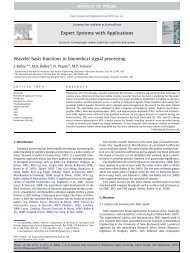Wavelet basis functions in biomedical signal processing - SPAN LAB
Wavelet basis functions in biomedical signal processing - SPAN LAB
Wavelet basis functions in biomedical signal processing - SPAN LAB
You also want an ePaper? Increase the reach of your titles
YUMPU automatically turns print PDFs into web optimized ePapers that Google loves.
J. Rafiee et al. / Expert Systems with Applications 38 (2011) 6190–6201 6197db44Channel 1900880Evaluation Criterionx 10 62db44db44Channel 2Channel 3Evaluation Criterion860840660640620Db44 & Db45HaarForearm Pronation5 10 15 20 25 30 35 40 45HaarDb44 & Db45Spread F<strong>in</strong>gers15 10 15 20 25 30 35 40 4500 50 100 150 200 250 300Mother wavelet <strong>functions</strong>Fig. 13. Trend of Daubechies family vs. evaluation criterion <strong>in</strong> Intramuscular EMG<strong>signal</strong>s for two motions.Fig. 11. Evaluation criterion (no unit) across 324 mother wavelet candidates forEEG <strong>signal</strong>s across three channels (Pz, POz, Oz).Evaluation Criterion21.510.5x 10 7db45Haardb44shan0.2-0.1shan0.1-0.1cmor3-0.1cmor4-0.1fbsp1-0.1-0.1shan0.5-0.1fbsp3-0.1-0.1fbsp2-0.1-0.1fbsp1-0.2-0.1fbsp2-0.2-0.1fbsp3-0.2-0.1bior3.1gaus1cgau1rbio3.1Evaluation Criterion80007000600050004000300020001000db45db44cmor1-0.01two motionsshan0.2-0.1dmeymeyrcmor1-0.1cmor4-0.1shan0.5-0.1fbsp1-0.2-0.1shan5-0.2shan1-0.4 fbsp3-0.2-0.9fbsp3-0.2-0.1fbsp2-0.2-0.1fbsp1-0.2-0.2cmor1-1.5fbsp3-0.1-0.1rbio5-5fbsp2-0.1-0.1fbsp1-0.1-0.1 bior3-100 50 100 150 200 250 300Mother wavelet <strong>functions</strong>Fig. 12. Evaluation criterion (no unit) vs. mother wavelets for VPA <strong>signal</strong>s recordedfrom one subject.Intramuscular EMG <strong>signal</strong>s. As shown, the EC <strong>in</strong>creases slightly <strong>in</strong>low-order db and decreases slightly for high-order db. This demonstratesthat Daubechies <strong>functions</strong> do not behave dramatically differenton the bio<strong>signal</strong>s, while rang<strong>in</strong>g from db1 to db43. It alsohighlights the likely limitation of the mostly lower order Daubechiesthat typically are used <strong>in</strong> prior research. The trend changesdramatically for db44, which cannot be seen <strong>in</strong> Fig. 13 due to scal<strong>in</strong>grestrictions.db44 and db45 are the most similar <strong>functions</strong> as the other 322<strong>functions</strong> have pronouncedly poorer performance (similarity).Closer exam<strong>in</strong>ation of the evaluation criterion (see Figs. 12 and14) for VPA and <strong>in</strong>tramuscular EMG reveals some variability of fitamongst other function families. To demonstrate the difference betweendb44 and the other <strong>functions</strong>, the cont<strong>in</strong>uous wavelet coefficientsof one of the segmented unit <strong>signal</strong>s us<strong>in</strong>g db44 has been0Mother wavelet <strong>functions</strong>Fig. 14. Evaluation criterion (no unit) vs. mother wavelets for <strong>in</strong>tramuscular EMG<strong>signal</strong>s recorded from one of the six channels of data acquisition system.compared to those calculated with the Morlet function, whichhas been used frequently <strong>in</strong> previous research (see Figs. 15 and16, see Fig. 17 for decomposition scale) (e.g. Saravanan, KumarSiddabattuni, & Ramachandran, 2008). The difference betweenthe values of the CWC (Y-axis) calculated by db44 is much higherthan those calculated by Morlet function. Moreover, periodic s<strong>in</strong>usoidaltrends also are obvious us<strong>in</strong>g the db44. This is a very desirablefeature, because it means that periodic behavior can beextracted from biological <strong>signal</strong>s us<strong>in</strong>g db44 function. This mightbe useful for preprocess<strong>in</strong>g biological <strong>signal</strong>s.Some other complex mother wavelets (<strong>in</strong> addition to db44 anddb45) show high similarity to EEG and VPA <strong>signal</strong>s (e.g. see Fig. 12).After db44 and db45, EEG <strong>signal</strong>s also display some similarity tobior 3.1 and other complex mother wavelets unlike the EMG. However,these differences appear m<strong>in</strong>or and appear due mostly tocomplex <strong>functions</strong> with different wavelet center frequency. Thecenter frequency varies simply with the frequency contents ofthe <strong>signal</strong>s.





